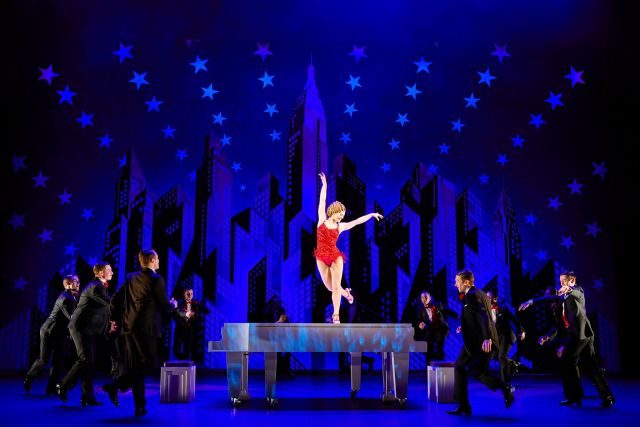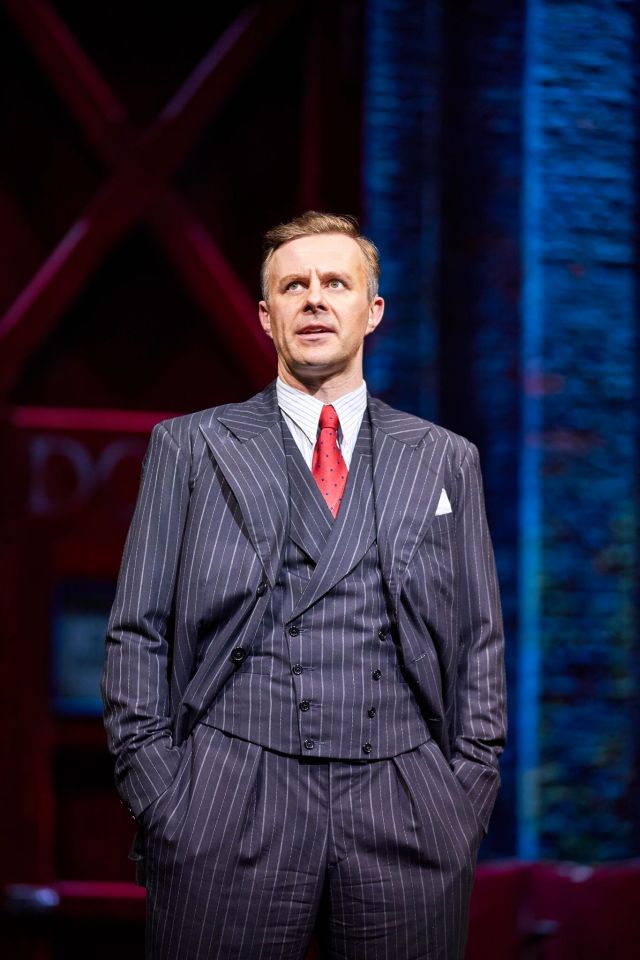42nd Street, Theatre Royal Drury Lane, review - 'sheer synchronised splendour' | reviews, news & interviews
42nd Street, Theatre Royal Drury Lane, review - 'sheer synchronised splendour'
42nd Street, Theatre Royal Drury Lane, review - 'sheer synchronised splendour'
Lavish revival delivers dazzle aplenty if not much depth

Can London support two dance musicals, each one dazzling in a different way? We're about to find out, now that the mother of all toe-tappers, 42nd Street, has set up shop a jeté or two away from where An American in Paris is achieving balletic lift-off.
Don't look for characterisation or depth, or even a book that makes much sense, even in a production directed by the show's co-author, Mark Bramble. The point here isn't individual revelation (or even consistency) but, instead, the rarely-encountered sight and sound of a mercilessly drilled ensemble all but knocking themselves out to deliver the goods. Add in the freshest pit orchestra I've heard in many a long year – kudos on that front to Jae Alexander's brass-intensive band – and it's no surprise that the audience lingers until the very last note to savour the goods. Or, at least, to revel in the thrill of perfectly arrived-at precision before we all make our way back into the random hurly-burly otherwise known as life.
Indeed, while memory can be a tricky thing, I'm tempted to think of this as the best 42nd Street in my experience since the fabled Broadway original that I saw as a theatre-mad teen in 1980. It's far more satisying than Bramble's own 2001 Broadway revival that was notable mostly for Christine Ebersole's easeful occupancy of the diva star part here taken with rather more effort by Grammy winner Sheena Easton, marking her West End debut. The diminutive performer boasts some impressive pipes and trills her way beautifully through her two first-act solos, one of which ("Boulevard of Broken Dreams") is new to the piece. She turns coarse, alas, in the book scenes, her unplaceable accent flitting between faux-British and Bronx squawk; a part defined more or less entirely by style could use a touch more of it.
The fact is, the role of Dorothy Brock may attract the name player, but the abiding glory of the piece resides in the row after row of nameless dancers who populate one eye-popping set piece and showstopper after another. Oh, and it helps in a show wherein a star is born to have a young ingenue in the part of that guileless Pennsylvanian, Peggy Sawyer, who truly suggests herself as a discovery:  (pictured above, centre) in this production is that and more, anchoring the material with equal measures of sweetness and grit that never once turn metallic. (This is the role that back in the day launched a young unknown by the name of Catherine Zeta-Jones.)
(pictured above, centre) in this production is that and more, anchoring the material with equal measures of sweetness and grit that never once turn metallic. (This is the role that back in the day launched a young unknown by the name of Catherine Zeta-Jones.)
 The plot barely exists and is familiar to many in any case: a (fictional) 1933 musical called Pretty Lady is being fine-tooled for Broadway when leading lady Brock suffers an injury that in turn requires the newly promoted and perpetually wide-eyed Sawyer to slay them in the aisles, as of course she does. Along the way, our newly annointed theatrical saviour enjoys romantic approaches from both fellow performer Billy Lawlor (Stuart Neal, winningly indefatigable) and from Pretty Lady's hard-boiled producer, Julian Marsh. That part – indelibly associated for those of a certain vintage with the magnificent Jerry Orbach – is here taken to stirring results by Tom Lister (pictured above), a TV name who brings surprising gravitas to the thrilling closing sequence in which the backstage bustle clears so as to give pride of place to the questing title number and its paean to Times Square in all that area's pre-Disney tawdry glory.
The plot barely exists and is familiar to many in any case: a (fictional) 1933 musical called Pretty Lady is being fine-tooled for Broadway when leading lady Brock suffers an injury that in turn requires the newly promoted and perpetually wide-eyed Sawyer to slay them in the aisles, as of course she does. Along the way, our newly annointed theatrical saviour enjoys romantic approaches from both fellow performer Billy Lawlor (Stuart Neal, winningly indefatigable) and from Pretty Lady's hard-boiled producer, Julian Marsh. That part – indelibly associated for those of a certain vintage with the magnificent Jerry Orbach – is here taken to stirring results by Tom Lister (pictured above), a TV name who brings surprising gravitas to the thrilling closing sequence in which the backstage bustle clears so as to give pride of place to the questing title number and its paean to Times Square in all that area's pre-Disney tawdry glory.
Lister's ability to own an empty stage aside, the reason for being for any 42nd Street is size, size, and more size, tethered to a Technicolor bravura whereby amplitude is its own reward alongside those Harry Warren-Al Dubin songs. I noticed that I was one of many who sat smiling open-mouthed at the Busby Berkeley-style bravura of "Dames", the dancers' scissor formations reflected back at the chorines, not to mention elsewhere the outsized coins or staircases seemingly without end that make this Depression-era artefact as important an antidote to our troubled times as was defiantly the case back then. (Randy Skinner's choreography reprises but also reinvents Gower Champion's storied original.)
This revival doesn't push the period hard: too much ordinary life isn't allowed to cloud Douglas W Schmidt's fantasia-filled sets (some early spelling mistakes of star performers of the age now corrected) or the sequined extravagance of Roger Kirk's costumes. And when the stage all but threatens to buckle under the weight of that thunderous assemblage attacking the title number as if their very existence depended on it, well, this "lullaby of Broadway" more or less pummels its public into blissful submission.
- 42nd Street at the Theatre Royal Drury Lane until 22 July
- More theatre reviews on theartsdesk
The future of Arts Journalism
You can stop theartsdesk.com closing!
We urgently need financing to survive. Our fundraising drive has thus far raised £33,000 but we need to reach £100,000 or we will be forced to close. Please contribute here: https://gofund.me/c3f6033d
And if you can forward this information to anyone who might assist, we’d be grateful.

Subscribe to theartsdesk.com
Thank you for continuing to read our work on theartsdesk.com. For unlimited access to every article in its entirety, including our archive of more than 15,000 pieces, we're asking for £5 per month or £40 per year. We feel it's a very good deal, and hope you do too.
To take a subscription now simply click here.
And if you're looking for that extra gift for a friend or family member, why not treat them to a theartsdesk.com gift subscription?
more Theatre
 A Christmas Carol, Old Vic review – tidings of discomfort and noise
This venue’s annual festive classic is seasonally joyous, but its writing is frankly patronizing
A Christmas Carol, Old Vic review – tidings of discomfort and noise
This venue’s annual festive classic is seasonally joyous, but its writing is frankly patronizing
![The cast of [title of show] - only in musical theatre...](https://theartsdesk.com/sites/default/files/styles/thumbnail/public/mastimages/0X5A2776-Edit.jpg?itok=qtQn1evO) [title of show], Southwark Playhouse review - two guys and two girls write about writing, delightfully
Revival of New York show lifts the spirits
[title of show], Southwark Playhouse review - two guys and two girls write about writing, delightfully
Revival of New York show lifts the spirits
 ARK: United States V by Laurie Anderson, Aviva Studios, Manchester review - a vessel for the thoughts and imaginings of a lifetime
Despite anticipating disaster, this mesmerising voyage is full of hope
ARK: United States V by Laurie Anderson, Aviva Studios, Manchester review - a vessel for the thoughts and imaginings of a lifetime
Despite anticipating disaster, this mesmerising voyage is full of hope
 Wolves on Road, Bush Theatre review - exciting dialogue, but flawed plotting
New play about young black men and cryptocurrency is sadly predictable
Wolves on Road, Bush Theatre review - exciting dialogue, but flawed plotting
New play about young black men and cryptocurrency is sadly predictable
 Burnt Up Love, Finborough Theatre review - scorching new play
Super writing and acting jolts us out of complacency
Burnt Up Love, Finborough Theatre review - scorching new play
Super writing and acting jolts us out of complacency
 L’Addition, BAC review - top billing for physical comedy duo
The latest in Forced Entertainment’s 40 years of experiment is a thought-tickling farce
L’Addition, BAC review - top billing for physical comedy duo
The latest in Forced Entertainment’s 40 years of experiment is a thought-tickling farce
 Barcelona, Duke of York's Theatre review - Lily Collins migrates from France to Spain
The 'Emily in Paris' star surrenders to cliche - or does she?
Barcelona, Duke of York's Theatre review - Lily Collins migrates from France to Spain
The 'Emily in Paris' star surrenders to cliche - or does she?
 Guards at the Taj, Orange Tree Theatre review - miniature marvel with rich resonances
Rajiv Joseph’s play pitting beauty against duty gets an impressive staging
Guards at the Taj, Orange Tree Theatre review - miniature marvel with rich resonances
Rajiv Joseph’s play pitting beauty against duty gets an impressive staging
 The Buddha of Suburbia, Barbican Theatre review - farcical fun, but what about the issues?
Hanif Kureishi classic gets a compulsively comic makeover from Emma Rice
The Buddha of Suburbia, Barbican Theatre review - farcical fun, but what about the issues?
Hanif Kureishi classic gets a compulsively comic makeover from Emma Rice
 How To Survive Your Mother, King's Head Theatre review - mummy issues drive autobiographical dramedy
Lots of heartache, but a strange void where the heart of the play should be
How To Survive Your Mother, King's Head Theatre review - mummy issues drive autobiographical dramedy
Lots of heartache, but a strange void where the heart of the play should be
 Dr Strangelove, Noël Coward Theatre review - an evening of different parts
Kubrick’s humour doesn't always detonate as it should in Armando Iannucci's version
Dr Strangelove, Noël Coward Theatre review - an evening of different parts
Kubrick’s humour doesn't always detonate as it should in Armando Iannucci's version
 Reykjavik, Hampstead Theatre review - drama frozen by waves of detail
Richard Bean’s new play revisits the Hull fishing industry of the 1970s
Reykjavik, Hampstead Theatre review - drama frozen by waves of detail
Richard Bean’s new play revisits the Hull fishing industry of the 1970s

Add comment